Relationship between Microstructure and Corrodibility of Local Dry Underwater Laser Welded 304 Stainless Steel
Abstract
1. Introduction
2. Materials and Experimental Procedures
2.1. Materials and Laser Welding Process
2.2. Microstructure Analysis
2.3. Corrosion Testing
3. Results
3.1. Surface Morphology and Radiographic Testing
3.2. Analysis of Weld Area Microstructure
3.2.1. Optical Microscopy
3.2.2. Electron Backscatter Diffraction
3.2.3. Electron Probe Microanalysis
3.2.4. Vickers Hardness
3.3. Corrosion Characteristics of Weld Area
3.3.1. Potentiodynamic Polarization Corrosion Testing
3.3.2. Multiple Factors Govern Corrosion
4. Conclusions
- (1)
- Using both UWLW and in-air laser welding processes, welded regions with no defects were obtained when 2 kW of laser power was used and both specimens consisted of lathy and skeletal ferrites in the center of the weld area. In particular, UWLW was characterized by the formation of fine ferrite with remarkably high microhardness because of the higher cooling rate for the process. The welding width generated during the UWLW was 3.82 mm due to the steep thermal gradient, which was narrower than that generated in air (4.8 mm).
- (2)
- The specimen prepared via UWLW had high residual stress because of the high cooling rate. It had a LAGB ratio approximately 1.5 times higher and a HAGB ratio approximately 0.6 times less than those of the specimen prepared via in-air laser welding. In particular, for UWLW, the fraction of the ∑3 boundaries was increased remarkably, by approximately 20%, compared with the in-air laser-welded specimen.
- (3)
- The UWLW specimen had a higher residual stress and relatively frequent micro-Cr carbide in the weld area than the in-air laser-welded specimen, and it was expected to be susceptible to corrosion. However, there was no significant difference between the corrosion rate of both welded specimens. It resulted from the small average grain size and excellent GB characteristic of UWLW. Corrosion was not determined by a single factor. Welding residual stress, GB size, precipitates in the grains, and GB characteristics were factors that had complex effects on the corrodibility of the welded part. However, among these factors, the GB properties were shown to have the greatest impact in our corrosion studies.
Author Contributions
Funding
Data Availability Statement
Conflicts of Interest
References
- Yamashita, Y.; Kawano, T.; Mann, K. Underwater laser welding by 4 kW CW YAG laser. J. Nucl. Sci. Technol. 2001, 38, 891–895. [Google Scholar] [CrossRef]
- Gao, H.; Jiao, X.; Zhou, C.; Shen, Q.; Yu, Y. Study on remote control underwater welding technology applied in nuclear power station. Procedia Eng. 2011, 5, 4988–4993. [Google Scholar] [CrossRef]
- Wang, J.; Sun, Q.; Zhang, T. Analysis and improvement of underwater wet welding process stability with static mechanical constraint support. J. Manuf. Processes 2018, 34, 238–250. [Google Scholar] [CrossRef]
- Zhang, X.; Chen, W.; Ashida, E.; Matsuda, F. Relationship between weld quality and optical emissions in underwater Nd: YAG laser welding. Opt. Lasers Eng. 2004, 41, 717–730. [Google Scholar] [CrossRef]
- Han, L.; Wu, X.; Chen, G.; Wang, Z.; Fan, W. Local dry underwater welding of 304 stainless steel based on a microdrain cover. J. Mater. Process. Technol. 2019, 268, 47–53. [Google Scholar] [CrossRef]
- Xiong, J.; Yang, X.; Lin, W.; Liu, K. Microstructural characteristics and mechanical heterogeneity of underwater wet friction taper plug welded joints for low-alloy pipeline steel. Mater. Sci. Eng. A 2017, 695, 279–290. [Google Scholar] [CrossRef]
- Chen, B.; Tan, C.; Feng, J. A study on the arc characteristics of underwater wet welding process. Int. J. Adv. Manuf. Technol. 2016, 86, 557–564. [Google Scholar] [CrossRef]
- Swierczynska, A.; Fydrych, D.; Rogalski, G. Diffusible hydrogen management in underwater wet self-shielded flux cored arc welding. Int. J. Hydro. Ener. 2017, 42, 24532–24540. [Google Scholar] [CrossRef]
- Cui, L.; Yang, X.; Wang, D.; Hou, X.; Cao, J.; Xu, W. Friction taper plug welding for S355 steel in underwater wet conditions: Welding performance, microstructures and mechanical properties. Mater. Sci. Eng. A 2014, 611, 15–28. [Google Scholar] [CrossRef]
- Guo, N.; Xing, X.; Zhao, H.; Tan, C.; Feng, J.; Deng, Z. Effect of water depth on weld quality and welding process in underwater fiber laser welding. Mater. Des. 2017, 115, 112–120. [Google Scholar] [CrossRef]
- Fu, Y.; Guo, N.; Cheng, Q.; Zhang, D.; Feng, J. Underwater laser welding for 304 stainless steel with filler wire. J. Mater. Res. Technol. 2020, 9, 15648–15661. [Google Scholar] [CrossRef]
- Wang, K.; Shao, C.; Jiao, X.; Zhu, J.; Cai, Z.; Li, C. Investigation on microstructure and properties of duplex stainless steel welds by underwater laser welding with different shielding gas. Materials 2021, 14, 4744. [Google Scholar] [CrossRef] [PubMed]
- Guo, N.; Fu, Y.; Xing, X.; Liu, Y.; Zhao, S.; Feng, J. Underwater local dry cavity laser welding of 304 stainless steel. J. Mater. Process. Technol. 2018, 260, 146–155. [Google Scholar] [CrossRef]
- Guo, N.; Cheng, Q.; Zhang, X.; Fu, Y.; Huang, L. Microstructure and mechanical properties of underwater laser welding of titanium. Materials 2019, 12, 2703. [Google Scholar] [CrossRef]
- ASM. Handbook: Metallography and Microstructure; ASM International Materials Park: Russell Township, OH, USA, 2004; Volume 9, pp. 1047–1053. [Google Scholar]
- Mitra, S.; Arora, K.S.; Bhattacharya, B.; Singh, S.B. Effect of welding speed on the prediction accuracy of residual stress in laser welded 1.2 mm thick dual phase steel. Lasers Manuf. Mater. Process. 2020, 7, 74–87. [Google Scholar] [CrossRef]
- Guo, Y.; Han, E.-H.; Wang, J. Effects of forging and heat treatments on the microstructure and oxidation behavior of 316LN stainless steel in high temperature water. J. Mater. Sci. Technol. 2015, 31, 403–412. [Google Scholar] [CrossRef]
- Hou, J.; Peng, Q.J.; Shoji, T.; Wang, J.Q.; Han, E.-H.; Ke, W. Effects of cold working path on strain concentration, grain boundary microstructure and stress corrosion cracking in Alloy 600. Corros. Sci. 2011, 53, 2956–2962. [Google Scholar] [CrossRef]
- Song, D.; Kim, S.W.; Hwang, S.S.; Kim, D.J.; Lee, C.H. In situ investigation of intergranular stress corrosion cracking initiation and coalescence and effects of geometric and microstructural characteristics. Corrosion 2018, 74, 1385–1394. [Google Scholar] [CrossRef]
- Zhong, W.; Lin, J.-L.; Chen, Y.; Li, Z.; An, K.; Sutton, B.J.; Heuser, B.J. Microstructure, hardness, and residual stress of the dissimilar metal weldments of SA508-309L/308L–304L. Met. Mater. Trans. A 2021, 52, 1927–1928. [Google Scholar] [CrossRef]
- Xu, C.; Zhang, Y.; Liu, W.; Jin, Y.; Wen, L.; Sun, D. Influence of laser-welding on microstructure and corrosion properties of twinning-induced plasticity (TWIP) steel. Materials 2020, 13, 4315. [Google Scholar] [CrossRef]
- Randle, V. Twinning-related grain boundary engineering. Acta Mater. 2004, 52, 4067–4081. [Google Scholar] [CrossRef]
- Watanabe, T. The importance of grain boundary character distribution (GBCD) to recrystallization, grain growth and texture. Scr. Met. Mater. 1992, 27, 1497–1502. [Google Scholar] [CrossRef]
- Liu, T.; Bai, Q.; Ru, X.; Xia, S.; Zhong, X.; Lu, Y.; Shoji, T. Grain boundary engineering for improving stress corrosion cracking of 304 stainless steel. Mater. Sci. Technol. 2019, 35, 477–487. [Google Scholar] [CrossRef]
- ISO 17475:2005; Corrosion of metals and alloys—Electrochemical test methods—Guidelines for conducting potentiostatic and potentiodynamic polarization measurements. International Organization for Standardization: Geneva, Switzerland, 2005.
- Gertsman, V.Y.; Bruemme, S.M. Study of grain boundary character along intergranular stress corrosion crack paths in austenitic alloys. Acta Mater. 2001, 49, 1589–1598. [Google Scholar] [CrossRef]
- Raja, V.S.; Shoji, T. Stress Corrosion Cracking: Theory and Practice; Woodhead Publishing: Cambridge, UK, 2011; pp. 427–484. [Google Scholar]
- HSoltani, M.; Taye, M. Comparative study of AISI 304L stainless steels joints by TIG and Nd:YAG laser welding. J. Alloys Compd. 2018, 767, 112–121. [Google Scholar] [CrossRef]
- Li, K.; Li, D.; Liu, D.; Pei, G.; Sun, L. Microstructure evolution and mechanical properties of multiple-layer laser cladding coating of 308L stainless steel. Appl. Surf. Sci. 2015, 340, 143–153. [Google Scholar] [CrossRef]
- Rama, G.D.J.; Reddy, A.V.; Rao, K.P.; Reddy, G.M.; Sundar, J.K.S. Microstructure and tensile properties of Inconel 718 pulsed Nd-YAG laser welds. J. Mater. Process. Technol. 2005, 167, 73–82. [Google Scholar] [CrossRef]
- Lu, B.T.; Chen, Z.K.; Luo, J.L.; Patchett, B.M.; Xu, Z.H. Pitting and stress corrosion cracking behavior in welded austenitic stainless steel. Electrochim. Acta 2005, 50, 1391–1403. [Google Scholar] [CrossRef]
- Unnikrishnan, R.; Idury, K.S.N.S.; Ismaila, T.P.; Bhadauria, A.; Shekhawat, S.K.; Khatirkar, K.R.; Sapate, S.G. Effect of heat input on the microstructure, residual stresses and corrosion resistance of 304L austenitic stainless steel weldments. Mater. Charact. 2014, 93, 10–23. [Google Scholar] [CrossRef]
- Qi, J.; Huang, B.; Wang, Z.; Ding, H.; Xi, J.; Fu, W. Dependence of corrosion resistance on grain boundary characteristics in a high nitrogen CrMn austenitic stainless steel. J. Mater. Sci. Technol. 2017, 33, 1621–1628. [Google Scholar] [CrossRef]
- Tan, L.; Sridharan, K.; Allen, T.R.; Nanstad, R.K.; McClintock, D.A. Microstructure tailoring for property improvements by grain boundary engineering. J. Nucl. Mater. 2008, 374, 270–280. [Google Scholar] [CrossRef]
- Cheng, M.; He, P.; Lei, L.; Tan, X.; Wang, X.; Sun, Y.; Li, J.; Jiang, Y. Comparative studies on microstructure evolution and corrosion resistance of 304 and a newly developed high Mn and N austenitic stainless steel welded joints. Corros. Sci. 2021, 183, 109338. [Google Scholar] [CrossRef]
- Fu, Z.H.; Gou, G.Q.; Zhu, Z.Y.; Ma, C.P.; Yang, W.Q.; Zhang, L.L.; Hu, Y.C.; Gao, W. Stress corrosion cracking behavior of SUS301L-MT stainless steel laser-archybrid welded joints. Corros. Sci. 2018, 143, 23–30. [Google Scholar] [CrossRef]
- Zhang, L.; Lu, J.Z.; Luo, K.Y.; Feng, A.X.; Dai, F.Z.; Zhong, J.S.; Luo, M.; Zhang, Y.K. Residual stress, micro-hardness and tensile properties of ANSI 304 stainless steel thick sheet by fiber laser welding. Mater. Sci. Eng. A 2013, 561, 136–144. [Google Scholar] [CrossRef]
- Cui, C.Y.; Cui, X.G.; Ren, X.D.; Liu, T.T.; Hu, J.D.; Wang, Y.M. Microstructure and microhardness of fiber laser butt welded joint of stainless steel plates. Mater. Des. 2013, 49, 761–765. [Google Scholar] [CrossRef]
- Yang, Z.; Zhu, L.; Wang, S.; Ning, J.; Dun, Y.; Meng, G.; Xue, P.; Xu, P.; Xin, B. Effects of ultrasound on multilayer forming mechanism of Inconel 718 in directed energy deposition. Addit. Manuf. 2021, 48, 102462. [Google Scholar] [CrossRef]
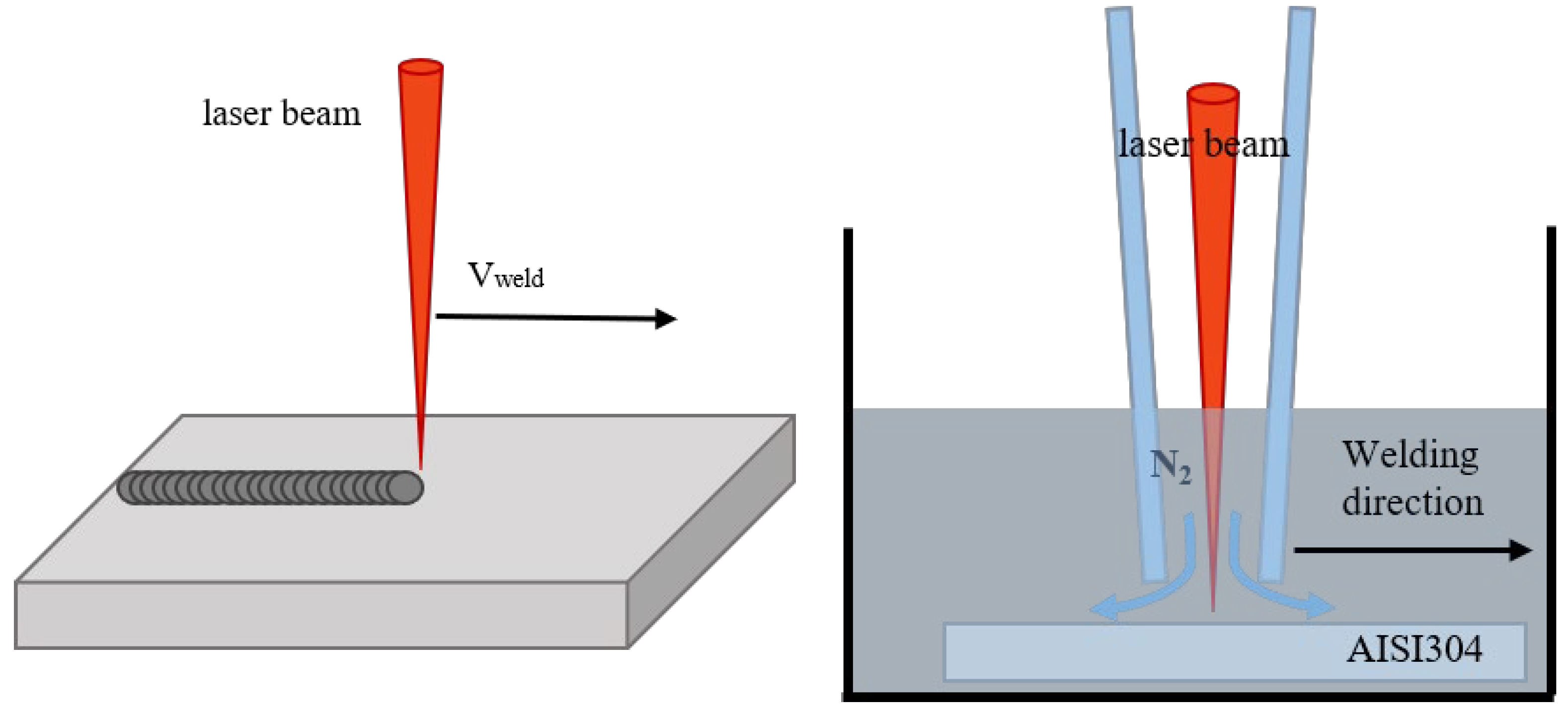
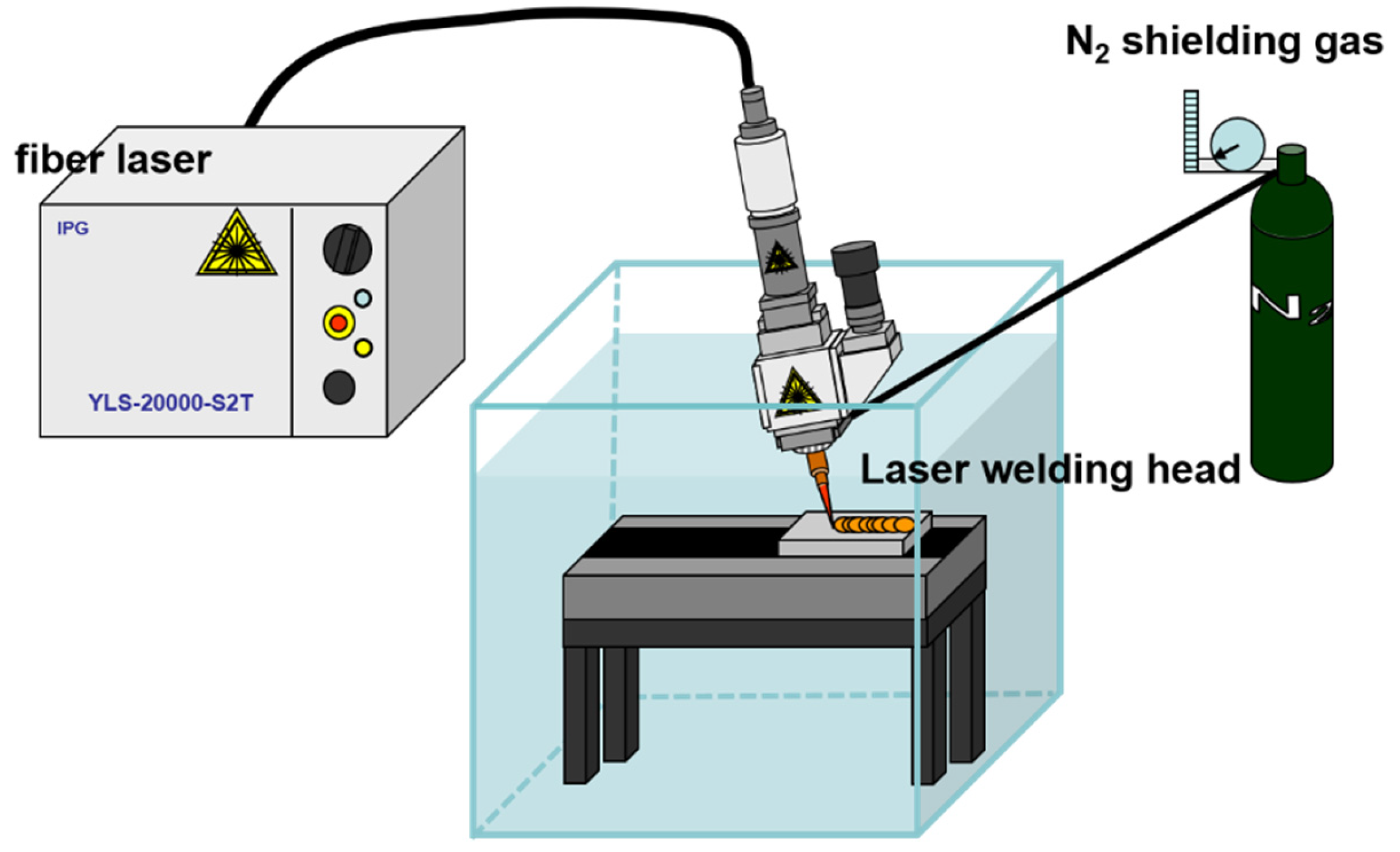





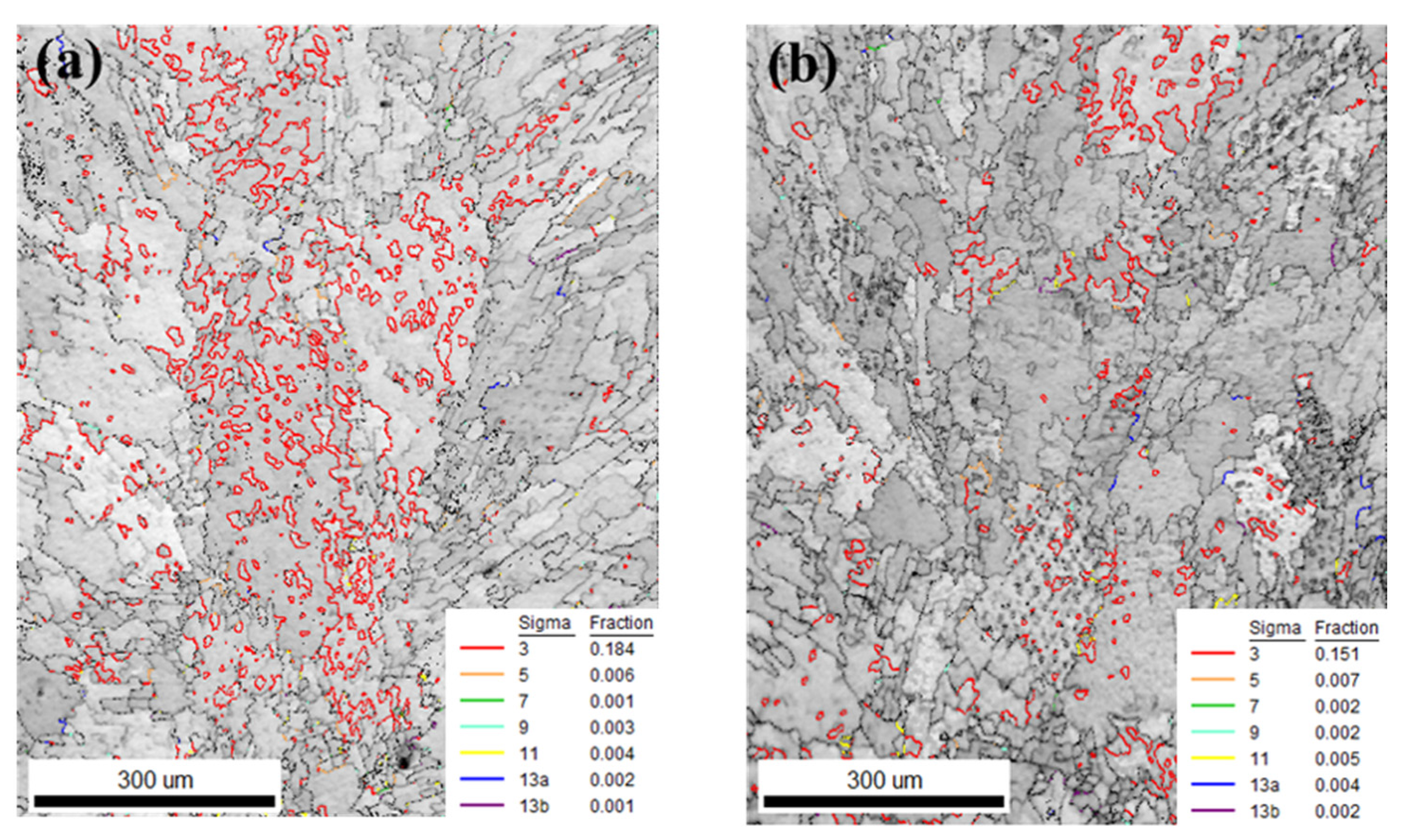
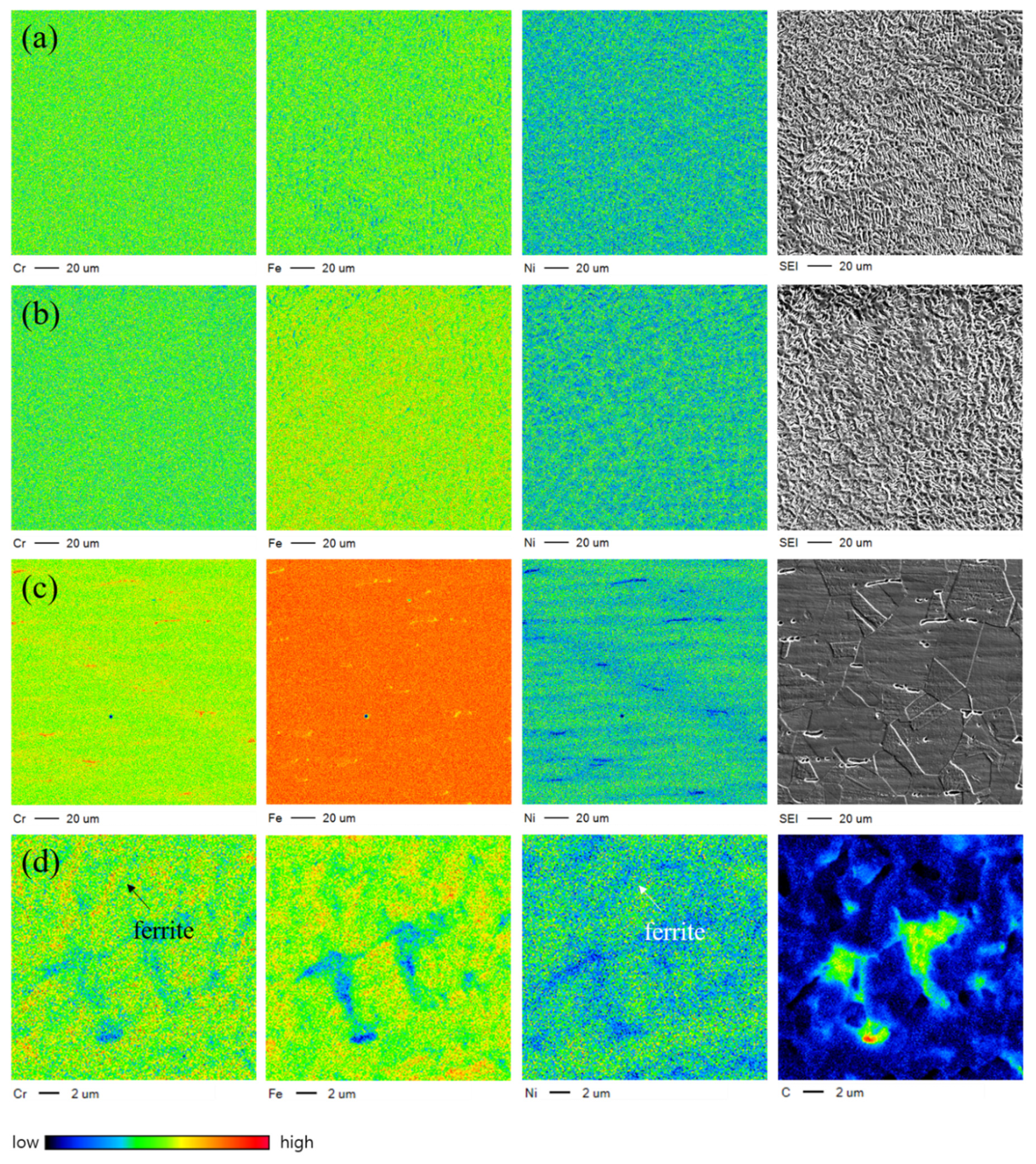


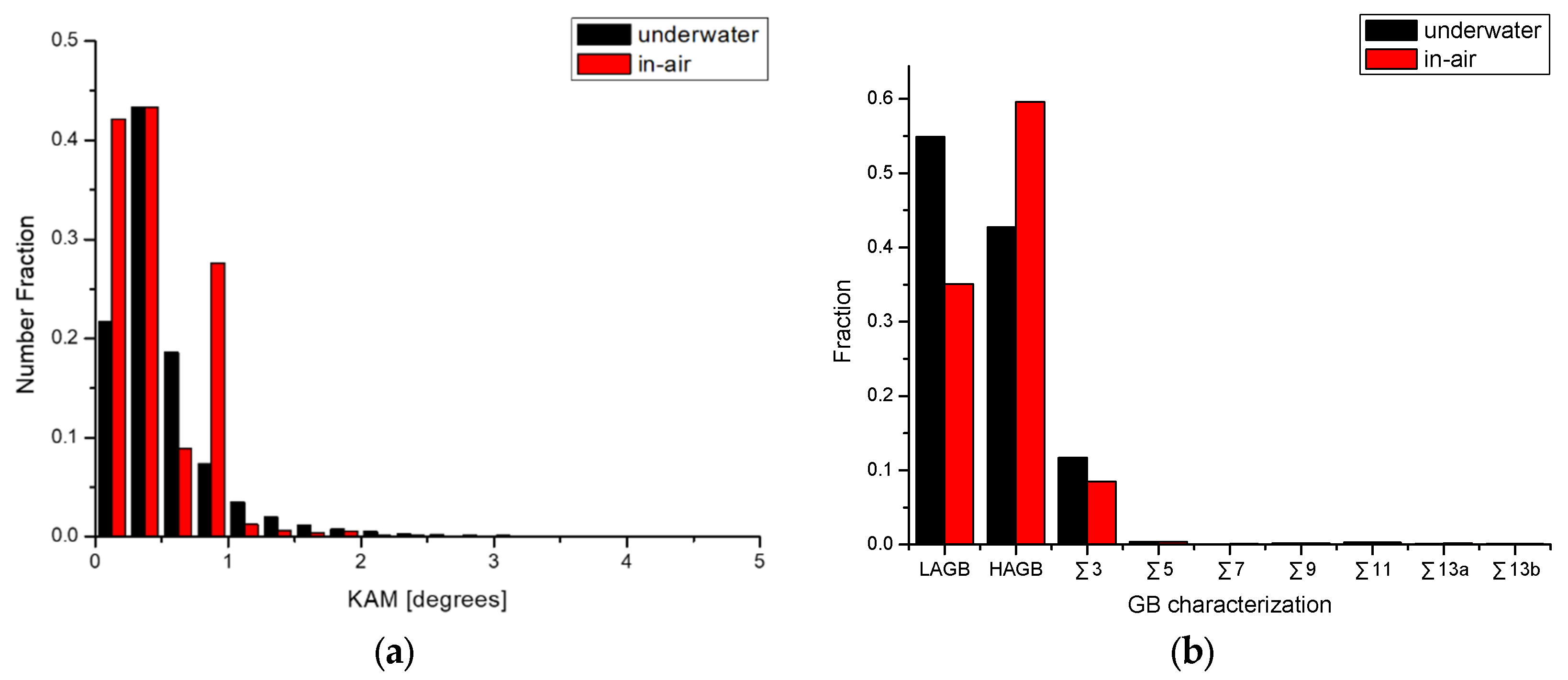
| Alloy | Ni | Cr | S | Si | Mn | C | P | Fe |
|---|---|---|---|---|---|---|---|---|
| 304 SS | 8 | 18 | 0.03 | 0.1 | 0.2 | 0.08 | 0.045 | Bal. |
| Specimen No. | Laser Power (kW) | Shielding Gas Pressure (Bar) | Welding Speed (mm/s) | Defocus Distance (mm) | Welding Condition |
|---|---|---|---|---|---|
| 1 | 2 | 5 | 0.5 | 0 | Underwater |
| 2 | 4 | 5 | 0.5 | 0 | Underwater |
| 3 | 6 | 5 | 0.5 | 0 | Underwater |
| R1 | 2 | 5 | 0.5 | 0 | In air |
| R2 | 4 | 5 | 0.5 | 0 | In air |
| R3 | 6 | 5 | 0.5 | 0 | In air |
| Specimen | Ecorr (V, SCE) | Icorr (μA/cm3) | Corrosion (mm/Year) | |
|---|---|---|---|---|
| Base Metal | No.1 | −0.237 | 0.748 | 0.01 |
| No.2 | −0.215 | 0.613 | 0.01 | |
| Average | −0.226 | 0.680 | 0.01 | |
| In air | No.1 | 0.120 | 0.001 | 0.00 |
| No.2 | 0.012 | 0.001 | 0.00 | |
| Average | 0.066 | 0.001 | 0.00 | |
| Underwater | No.1 | −0.067 | 0.000 | 0.00 |
| No.2 | −0.101 | 0.001 | 0.00 | |
| Average | −0.084 | 0.001 | 0.00 | |
Publisher’s Note: MDPI stays neutral with regard to jurisdictional claims in published maps and institutional affiliations. |
© 2022 by the authors. Licensee MDPI, Basel, Switzerland. This article is an open access article distributed under the terms and conditions of the Creative Commons Attribution (CC BY) license (https://creativecommons.org/licenses/by/4.0/).
Share and Cite
Song, D.; Choi, J.; Shin, D.; Lee, S.-J. Relationship between Microstructure and Corrodibility of Local Dry Underwater Laser Welded 304 Stainless Steel. Metals 2022, 12, 1904. https://doi.org/10.3390/met12111904
Song D, Choi J, Shin D, Lee S-J. Relationship between Microstructure and Corrodibility of Local Dry Underwater Laser Welded 304 Stainless Steel. Metals. 2022; 12(11):1904. https://doi.org/10.3390/met12111904
Chicago/Turabian StyleSong, Danbi, Jungsoo Choi, Dongsig Shin, and Su-Jin Lee. 2022. "Relationship between Microstructure and Corrodibility of Local Dry Underwater Laser Welded 304 Stainless Steel" Metals 12, no. 11: 1904. https://doi.org/10.3390/met12111904
APA StyleSong, D., Choi, J., Shin, D., & Lee, S.-J. (2022). Relationship between Microstructure and Corrodibility of Local Dry Underwater Laser Welded 304 Stainless Steel. Metals, 12(11), 1904. https://doi.org/10.3390/met12111904






